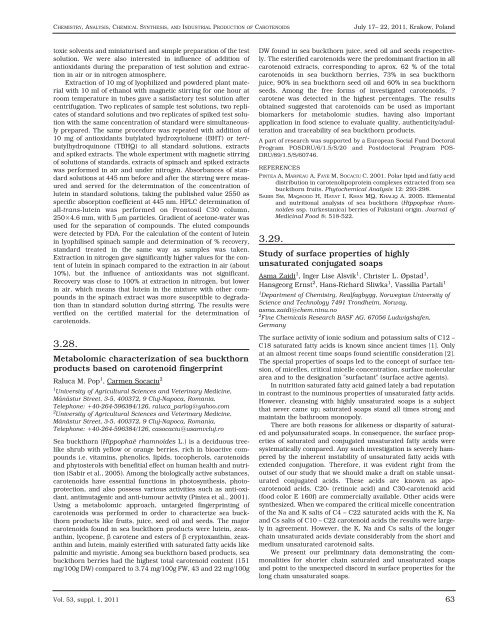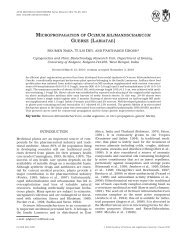ACTA BIOLOGICA CRACOVIENSIA
ACTA BIOLOGICA CRACOVIENSIA
ACTA BIOLOGICA CRACOVIENSIA
You also want an ePaper? Increase the reach of your titles
YUMPU automatically turns print PDFs into web optimized ePapers that Google loves.
CHEMISTRY, ANALYSIS, CHEMICAL SYNTHESIS, AND INDUSTRIAL PRODUCTION OF CAROTENOIDS<br />
toxic solvents and miniaturised and simple preparation of the test<br />
solution. We were also interested in influence of addition of<br />
antioxidants during the preparation of test solution and extraction<br />
in air or in nitrogen atmosphere.<br />
Extraction of 10 mg of lyophilized and powdered plant material<br />
with 10 ml of ethanol with magnetic stirring for one hour at<br />
room temperature in tubes gave a satisfactory test solution after<br />
centrifugation. Two replicates of sample test solutions, two replicates<br />
of standard solutions and two replicates of spiked test solution<br />
with the same concentration of standard were simultaneously<br />
prepared. The same procedure was repeated with addition of<br />
10 mg of antioxidants butylated hydroxytoluene (BHT) or tertbutylhydroquinone<br />
(TBHQ) to all standard solutions, extracts<br />
and spiked extracts. The whole experiment with magnetic stirring<br />
of solutions of standards, extracts of spinach and spiked extracts<br />
was performed in air and under nitrogen. Absorbances of standard<br />
solutions at 445 nm before and after the stirring were measured<br />
and served for the determination of the concentration of<br />
lutein in standard solutions, taking the published value 2550 as<br />
specific absorption coefficient at 445 nm. HPLC determination of<br />
all-trans-lutein was performed on Prontosil C30 column,<br />
250×4.6 mm, with 5 μm particles. Gradient of acetone-water was<br />
used for the separation of compounds. The eluted compounds<br />
were detected by PDA. For the calculation of the content of lutein<br />
in lyophilised spinach sample and determination of % recovery,<br />
standard treated in the same way as samples was taken.<br />
Extraction in nitrogen gave significantly higher values for the content<br />
of lutein in spinach compared to the extraction in air (about<br />
10%), but the influence of antioxidants was not significant.<br />
Recovery was close to 100% at extraction in nitrogen, but lower<br />
in air, which means that lutein in the mixture with other compounds<br />
in the spinach extract was more susceptible to degradation<br />
than in standard solution during stirring. The results were<br />
verified on the certified material for the determination of<br />
carotenoids.<br />
3.28.<br />
Metabolomic characterization of sea buckthorn<br />
products based on carotenoid fingerprint<br />
Raluca M. Pop 1 , Carmen Socaciu 2<br />
1University of Agricultural Sciences and Veterinary Medicine,<br />
Mãnãstur Street, 3-5, 400372, 9 Cluj-Napoca, Romania,<br />
Telephone: +40-264-596384/126, raluca_parlog@yahoo.com<br />
2University of Agricultural Sciences and Veterinary Medicine,<br />
Mãnãstur Street, 3-5, 400372, 9 Cluj-Napoca, Romania,<br />
Telephone: +40-264-596384/126, casocaciu@usamvcluj.ro<br />
Sea buckthorn (Hippophaë rhamnoides L.) is a deciduous treelike<br />
shrub with yellow or orange berries, rich in bioactive compounds<br />
i.e. vitamins, phenolics, lipids, tocopherols, carotenoids<br />
and phytosterols with benefitial effect on human health and nutrition<br />
(Sabir et al., 2005). Among the biologically active substances,<br />
carotenoids have essential functions in photosynthesis, photoprotection,<br />
and also possess various activities such as anti-oxidant,<br />
antimutagenic and anti-tumour activity (Pintea et al., 2001).<br />
Using a metabolomic approach, untargeted fingerprinting of<br />
carotenoids was performed in order to characterize sea buckthorn<br />
products like fruits, juice, seed oil and seeds. The major<br />
carotenoids found in sea buckthorn products were lutein, zeaxanthin,<br />
lycopene, β carotene and esters of β cryptoxanthin, zeaxanthin<br />
and lutein, mainly esterified with saturated fatty acids like<br />
palmitic and myristic. Among sea buckthorn based products, sea<br />
buckthorn berries had the highest total carotenoid content (151<br />
mg/100g DW) compared to 3.74 mg/100g FW, 43 and 22 mg/100g<br />
Vol. 53, suppl. 1, 2011<br />
DW found in sea buckthorn juice, seed oil and seeds respectively.<br />
The esterified carotenoids were the predominant fraction in all<br />
carotenoid extracts, corresponding to aprox. 62 % of the total<br />
carotenoids in sea buckthorn berries, 73% in sea buckthorn<br />
juice, 90% in sea buckthorn seed oil and 60% in sea buckthorn<br />
seeds. Among the free forms of investigated carotenoids, ?<br />
carotene was detected in the highest percentages. The results<br />
obtained suggested that carotenoids can be used as important<br />
biomarkers for metabolomic studies, having also important<br />
application in food science to evaluate quality, authenticity/adulteration<br />
and traceability of sea buckthorn products.<br />
A part of research was supported by a European Social Fund Doctoral<br />
Program POSDRU/6/1.5/S/20 and Postdoctoral Program POS-<br />
DRU/89/1.5/S/60746.<br />
REFERENCES<br />
PINTEA A, MARPEAU A, FAYE M, SOCACIU C. 2001. Polar lipid and fatty acid<br />
distribution in carotenolipoprotein complexes extracted from sea<br />
buckthorn fruits. Phytochemical Analysis 12: 293-298.<br />
SABIR SM, MAQSOOD H, HAYAT I, KHAN MQ, KHALIQ A. 2005. Elemental<br />
and nutritional analysis of sea buckthorn (Hippophae rhamnoides<br />
ssp. turkestanica) berries of Pakistani origin. Journal of<br />
Medicinal Food 8: 518-522.<br />
3.29.<br />
July 17– 22, 2011, Krakow, Poland<br />
Study of surface properties of highly<br />
unsaturated conjugated soaps<br />
Asma Zaidi1 , Inger Lise Alsvik1 , Christer L. Øpstad1 ,<br />
Hansgeorg Ernst2 , Hans-Richard Sliwka1 , Vassilia Partali1 1Department of Chemistry, Realfagbygg, Norwegian University of<br />
Science and Technology 7491 Trondheim, Norway,<br />
asma.zaidi@chem.ntnu.no<br />
2Fine Chemicals Research BASF AG, 67056 Ludwigshafen,<br />
Germany<br />
The surface activity of ionic sodium and potassium salts of C12 –<br />
C18 saturated fatty acids is known since ancient times [1]. Only<br />
at an almost recent time soaps found scientific consideration [2].<br />
The special properties of soaps led to the concept of surface tension,<br />
of micelles, critical micelle concentration, surface molecular<br />
area and to the designation "surfactant" (surface active agents).<br />
In nutrition saturated fatty acid gained lately a bad reputation<br />
in contrast to the numinous properties of unsaturated fatty acids.<br />
However, cleansing with highly unsaturated soaps is a subject<br />
that never came up; saturated soaps stand all times strong and<br />
maintain the bathroom monopoly.<br />
There are both reasons for alikeness or disparity of saturated<br />
and polyunsaturated soaps. In consequence, the surface properties<br />
of saturated and conjugated unsaturated fatty acids were<br />
systematically compared. Any such investigation is severely hampered<br />
by the inherent instability of unsaturated fatty acids with<br />
extended conjugation. Therefore, it was evident right from the<br />
outset of our study that we should make a draft on stable unsaturated<br />
conjugated acids. These acids are known as apocarotenoid<br />
acids. C20- (retinoic acid) and C30-carotenoid acid<br />
(food color E 160f) are commercially available. Other acids were<br />
synthesized. When we compared the critical micelle concentration<br />
of the Na and K salts of C4 – C22 saturated acids with the K, Na<br />
and Cs salts of C10 – C22 carotenoid acids the results were largely<br />
in agreement. However, the K, Na and Cs salts of the longer<br />
chain unsaturated acids deviate considerably from the short and<br />
medium unsaturated carotenoid salts.<br />
We present our preliminary data demonstrating the commonalities<br />
for shorter chain saturated and unsaturated soaps<br />
and point to the unexpected discord in surface properties for the<br />
long chain unsaturated soaps.<br />
63












